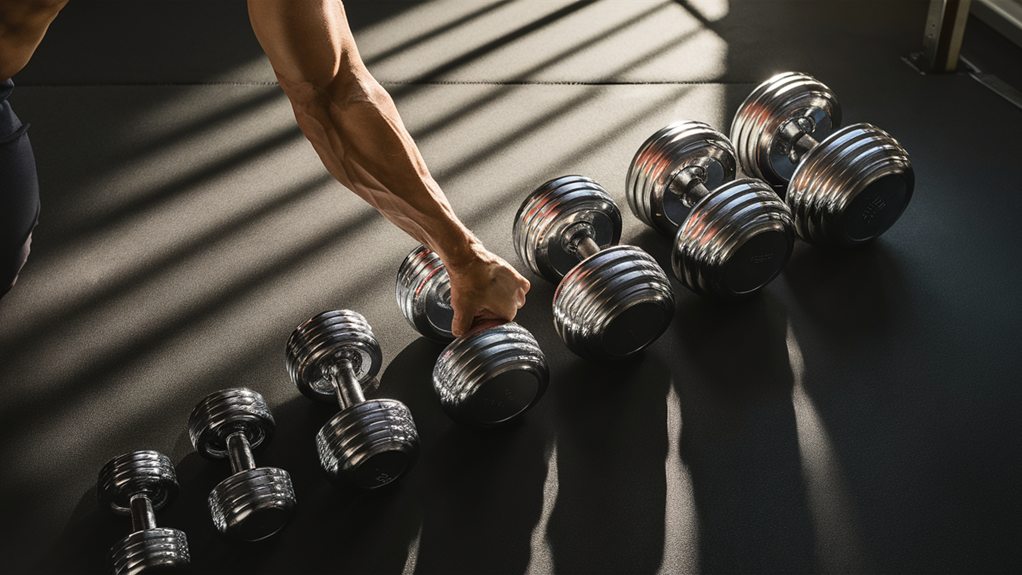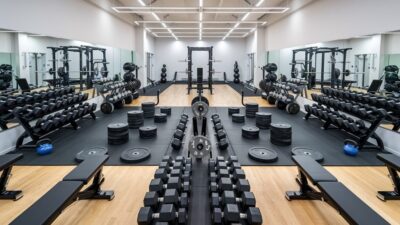Advanced strength techniques go beyond basic weight training to help you break through plateaus and maximize muscle growth. You'll want to focus on progressive overload principles, including adjusting variables like sets, reps, and tempo, while incorporating specialized methods such as supersets and drop sets. Elite training also relies on proper periodization, which structures your workouts into specific cycles for ideal gains. Neural adaptations play an essential role, so emphasize perfect form and explosive movements with heavy weights (85-95% of max). When combined with strategic recovery methods, including quality sleep and nutrition, these techniques can transform your strength potential and reveal new levels of performance.
Understanding Progressive Overload Principles

While many lifters focus solely on adding weight to the bar, progressive overload encompasses multiple variables you can manipulate to continually challenge your muscles.
As you develop your advanced strength training techniques, you'll discover that increasing resistance is just one piece of the puzzle. Incorporating strength training into your routine can also help unleash weight loss by increasing muscle mass and boosting metabolism.
You can progress by adjusting your training volume through additional sets and reps, decreasing rest periods between exercises, or improving your movement quality.
When building strength with advanced methods, don't forget that tempo manipulation, like slowing down the eccentric phase of lifts, creates new stimulus for muscle growth and strength gains.
For strength training for advanced lifters, it's essential to understand that progression doesn't always mean hitting personal records every session.
You can create overload by increasing time under tension, adjusting exercise variations, or enhancing movement complexity.
For instance, you might switch from regular squats to pause squats, or add resistance bands to traditional exercises.
Remember to track these variables in your training log, as small improvements in any area contribute to your overall progression and help prevent plateaus.
Breaking Through Training Plateaus
Three major signs indicate you've hit a training plateau: stalled progress, decreased motivation, and persistent fatigue. When you're stuck in this frustrating position, it's time to shake up your routine with proven powerlifting techniques and strategic adjustments. Incorporating strength training benefits into your regimen can enhance your overall performance and recovery, making it easier to overcome these plateaus.
First, try implementing micro-loading, where you'll add smaller weight increments than usual, allowing your body to adapt gradually. You can use fractional plates or resistance bands to make these precise adjustments.
Next, consider changing your rep ranges dramatically, switching from your usual 8-12 reps to either very low (2-3) or very high (15-20) to challenge your muscles differently.
If you're still struggling, it's time to analyze your weak points. Record your lifts and identify where you're failing in each movement. You'll often find that incorporating pause reps, tempo training, or isolation exercises for lagging muscle groups can help break through stubborn plateaus.
Remember to adjust your recovery periods too, as overtraining might be holding you back. Sometimes, taking a strategic deload week can help you come back stronger and ready to progress again.
Advanced Superset Methods

Advanced superset training elevates your workout intensity while maximizing time efficiency in the gym. When you pair two exercises back-to-back without rest, you'll create a powerful stimulus for muscle growth and strength gains, which can be further enhanced by ensuring adequate protein intake to support muscle repair and recovery.
This demanding approach challenges your body in new ways, helping you break through plateaus and achieve better results in less time, as seen in studies on the role of protein in endurance.
- Antagonistic Supersets: Pair opposing muscle groups, like chest and back exercises, to maintain high performance while one muscle group recovers.
- Pre-exhaust Supersets: Combine an isolation exercise followed by a compound movement for the same muscle group, such as leg extensions before squats.
- Post-activation Potentiation: Start with a heavy compound lift followed by an explosive movement to enhance power output.
You'll want to structure your superset workouts carefully, paying attention to exercise selection and rest periods. Start with two to three superset pairs per workout, and gradually increase as your conditioning improves.
Remember to maintain proper form throughout each exercise, even as fatigue sets in. This advanced technique requires focus and dedication, but you'll see impressive results when implemented correctly.
Drop Set Programming
Drop set training represents one of the most intense muscle-building techniques you can employ in your strength program. When you perform drop sets, you'll start with a heavy weight, complete as many reps as possible, then quickly reduce the weight and continue without rest. This process continues through several weight reductions until you've thoroughly exhausted the target muscle group.
To maximize the effectiveness of drop sets, it's vital to guarantee adequate nutrition, particularly focusing on protein intake, which plays an important role in supporting muscle recovery and growth.
To implement drop sets effectively, you'll want to select exercises that allow for quick weight changes, such as machine exercises or dumbbell movements. Start with a weight you can lift for 8-10 reps, then reduce it by 20-30% for each drop. You'll typically perform 3-4 drops per set, and it's best to limit yourself to 1-2 exercises per muscle group using this technique.
Since drop sets are incredibly demanding on your muscles and nervous system, you shouldn't use them in every workout. Instead, program them strategically every 1-2 weeks per muscle group. This approach will help you avoid overtraining while still reaping the benefits of increased muscle growth and endurance.
Periodization For Elite Lifters

Elite lifters require a sophisticated approach to training through carefully structured periodization cycles. When you're training at an advanced level, you'll need to carefully plan your lifting schedule across multiple phases, each designed to build upon the previous one. Incorporating a variety of equipment such as kettlebells and resistance bands can enhance your functional training and contribute to your overall strength development, as these tools are effective for essential equipment for effective functional training.
Your periodization plan should account for competition dates, recovery periods, and peak performance windows.
- Macrocycles span 6-12 months and encompass your entire training year, including offseason work, competition prep, and recovery phases.
- Mesocycles last 4-6 weeks and focus on specific adaptations, like hypertrophy, strength, or power development.
- Microcycles break down into weekly training blocks that manage volume, intensity, and exercise selection.
You'll want to structure your periodization so that you're peaking at the right time for competitions or key performance goals. This means you'll gradually increase training intensity while decreasing volume as you approach important dates.
It's vital to track your progress through detailed training logs, monitoring how your body responds to different phases. You can adjust your cycles based on recovery needs, ensuring you don't overtrain while maximizing your strength gains through strategic programming.
Recovery Strategies For Heavy Training
Proper recovery methods complement the sophisticated periodization plans that elite lifters follow. When you're training at high intensities, your body needs specific strategies to bounce back and rebuild stronger than before.
It's important to remember that recovery isn't just about rest; incorporating endurance training can also enhance your overall fitness and resilience, leading to improved cardiovascular health. You'll want to prioritize quality sleep, getting 8-10 hours each night, since this is when your muscles repair themselves and your hormones regulate.
Active recovery is just as essential as rest days, and you'll benefit from light movement like walking, swimming, or gentle stretching between heavy training sessions.
Your nutrition needs to be dialed in too, with plenty of protein spread throughout the day, complex carbs to replenish energy stores, and healthy fats to support hormone production. Don't forget about hydration, as you'll need to drink enough water to support muscle function and recovery processes.
You can also incorporate contrast therapy, alternating between hot and cold treatments, to reduce inflammation and speed up recovery.
Massage, foam rolling, and compression gear are additional tools you'll find helpful, especially after particularly demanding workouts.
Maximizing Neural Adaptations

Neural adaptations form the foundation of strength gains, particularly in the early stages of training. Your nervous system quickly learns to recruit more muscle fibers and coordinate their firing patterns more effectively, which means you'll get stronger even before your muscles grow larger.
To maximize these adaptations, you'll need to focus on quality movements and progressive overload.
You can enhance your neural adaptations through specific training strategies that target your nervous system's response to exercise. When you're working with heavy weights, your body needs to learn how to activate the right muscle fibers at the right time, and this process requires both consistency and proper technique.
- Train with weights that are 85-95% of your one-rep max, focusing on perfect form and explosive intent
- Include cluster sets in your routine, where you break up heavy sets with short rest periods
- Practice rate of force development exercises, like jump squats or medicine ball throws



